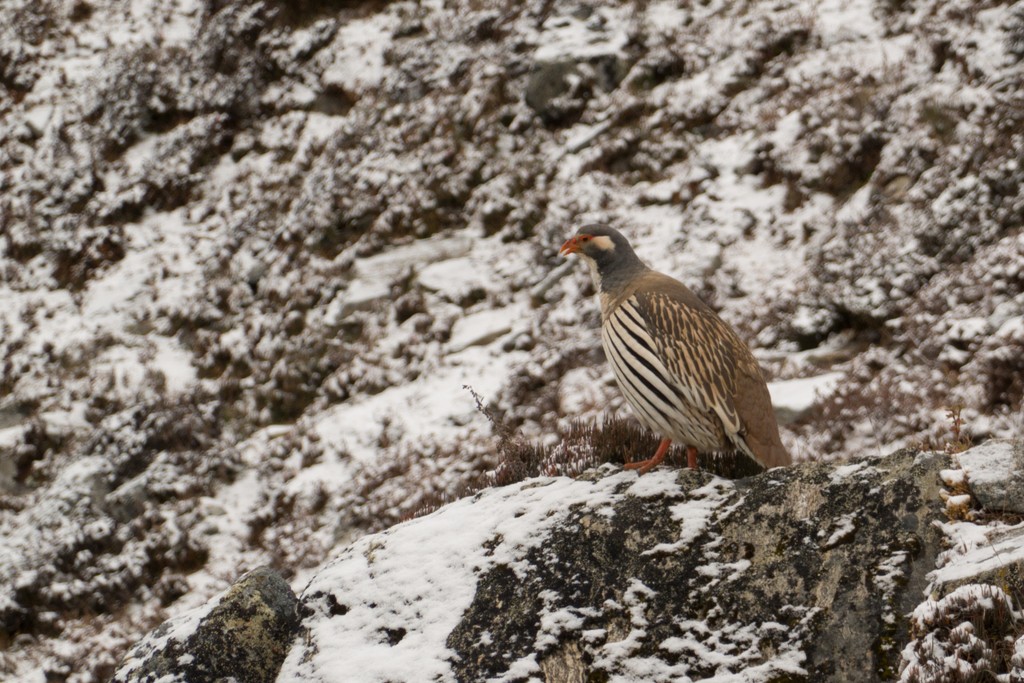Tibetan Snowcock
A species of Snowcocks Scientific name : Tetraogallus tibetanus Genus : Snowcocks
Tibetan Snowcock, A species of Snowcocks
Botanical name: Tetraogallus tibetanus
Genus: Snowcocks
Content
Description General Info
 Photo By moabhikers , used under CC-BY-NC-4.0 /Cropped and compressed from original
Photo By moabhikers , used under CC-BY-NC-4.0 /Cropped and compressed from original Description
Smaller than Himalayan snowcock, this species has a grey head and neck with a white patch behind the eye and above the dark cheek. Chin, throat and breast are white, with two grey bands on the breast. Grey wing coverts and tertials have a white trim. The secondaries have a broad white trailing edge that forms a wing band. Underparts are white with black streaks on flanks and belly. The tail is rufous brown and the undertail coverts are black. Legs and beaks are reddish. Sexes are similar, but female has buff in postocular patch, blackish and buff marks on sides of head, neck and breast-band, and lacks the tarsal spurs of the male. 
Size
56 cm
Nest Placement
Ground
Feeding Habits
Tibetan Snowcock's diet primarily includes grasses and herbs such as Stellaria, Saxifraga, Oxytropis, Potentilla, and Primula. They forage on the ground, occasionally forming large winter groups, and may feed alongside other species. Unique dietary specifics are scarce, yet its foraging behavior suggests adaptation to a high-altitude environment.
Habitat
The habitat of tibetan Snowcock comprises open slopes above the treeline, characterized by alpine pastures and stony ridges with a sparse covering of grass. These birds inhabit areas with extreme conditions, being found in the highest elevations suitable for their survival, and descend to somewhat lower altitudes during the winter season.
Dite type
Herbivorous
General Info
Feeding Habits
Bird food type
Behavior
This species is similar to the Himalayan snowcock, but prefers higher altitudes. During winter, they descend to lower altitudes and move around in coveys. When approached from below on a hill slope, they move up, stopping every now and then to look at the intruder, but when alarmed they fly away downwards crossing the valley/ravine. The flight is swift and will often make a whistling call in flight. They call several times while alighting and on settling from flight they shake their tails several times in the manner of willow ptarmigan. They call in the morning and evening, becoming quiet in the middle of the day. They keep to grass-covered plateaus and ridges or to the more barren and stony plains with very little vegetation. Though they do not keep sentries during feeding, while resting in the middle of the day, one or more of adult birds mount high boulders and keep a watch, warning the flocks on the approach of danger with loud prolonged whistles. Several calls have been described that include a chuckling that gradually becomes louder, a whistle and a curlew-like call. During summer, they form pairs and males are believed to be monogynous. The nest is a scrape, sparsely lined and sheltered under a stone or bush usually on the leeward side of a bare hill, and avoiding ground with vegetation. About 4 to 6 eggs are laid. The male stands sentinel while the females incubate. Both parent birds accompany the brood and adults perform distraction displays when the young are threatened, while the chicks crouch or hide between stones. Broods of more than one female have been found to form a single foraging group. 
Distribution Area
Tibetan snowcock are found on alpine pastures stony ridges above the tree line in the Pamirs of Tajikistan, Himalayas (from Ladakh to Arunachal Pradesh), Tibet and China. They are found in lower altitudes during winter or when there is heavy snowfall. In parts of its range there appears to be a clear separation of the distribution of this and the Himalayan snowcock while in others they appear to overlap. Since the Tibetan snowcock has a large distribution range and no visible declines in population, it has been considered a species of "least concern" by the IUCN. 